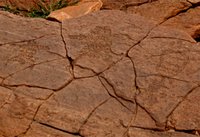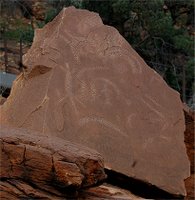 This is not about Robertson, it is about Rock Art on the Burrup Peninsula, in Western Australia. But I believe it is important enough to write about here.
This is not about Robertson, it is about Rock Art on the Burrup Peninsula, in Western Australia. But I believe it is important enough to write about here.Readers will be aware that I went to Broken Hill recently, and on that trip, we were shown ancient petroglyphs (rock art), said to date back 30,000 years. It was a very special moment for me to come face-to-face with something so special, so ancient, as that.
Rock Carvings:
Frog and other figures
 We were shown these Rock Engravings by local Aboriginal guides who are the custodians of the entire site, at Mutawintji. Clearly it is very special to them, and I am sure we were only shown the less significant works. The creatures depicted, especially the frogs, were important totemic figures for these people, related to their stories.
We were shown these Rock Engravings by local Aboriginal guides who are the custodians of the entire site, at Mutawintji. Clearly it is very special to them, and I am sure we were only shown the less significant works. The creatures depicted, especially the frogs, were important totemic figures for these people, related to their stories.These pieces of Rock Art rival the famous Cave Paintings of Altamira, in Spain which of course have been granted "World Heritage" status by UNESCO.
Rock Carving - figures

The Mutawintji Site is declared as a National Park, but that did not stop the rock (at left) from once being stolen. It was only recovered because the thieves had several punctures to their tyres on the way out from the Park, back to Broken Hill, because the huge weight of the rock was too much for their Kombi Van to cope with. That is not "protection", let alone "World Heritage" status.
*****
 Anyway, I heard a few weeks ago that the desirability of Environment Protection Act status for the Burrup Peninsula in Western Australia was being "reviewed" by the Minister for the Environment, Senator Ian Campbell. This is a huge area, famous for the largest collection of Rock Art in Australia. It happens to be in a convenient place for a giant petrochemical company, Woodside" to process Natural Gas. I ask myself why is it necessary for the Natural Gas pumping/condensing station to be placed in such a position as to destroy priceless, and ancient petroglyphs?
Anyway, I heard a few weeks ago that the desirability of Environment Protection Act status for the Burrup Peninsula in Western Australia was being "reviewed" by the Minister for the Environment, Senator Ian Campbell. This is a huge area, famous for the largest collection of Rock Art in Australia. It happens to be in a convenient place for a giant petrochemical company, Woodside" to process Natural Gas. I ask myself why is it necessary for the Natural Gas pumping/condensing station to be placed in such a position as to destroy priceless, and ancient petroglyphs?
The proposed industrial developments threaten to destroy one of the world's greatest concentrations of rock engravings. We are astonished that such a priceless piece of world cultural heritage should be threatened. The Dampier Archipelago is amongst the richest precinct for the art and archaeology of Australia's first peoples and is well known to specialists and enthusiasts around the world.
Answer: It is apparent that this is the home of the NorthWest Shelf Gas Project:
The Northwest Shelf Gas Project is the largest resource project ever undertaken in Australia. Gas is drilled at an offshore platform 130 kilometres north of Dampier and piped to the onshore treatment plant on the Burrup Peninsula. From here the gas is carried in a one thousand four hundred and fifty kilometre pipeline to domestic and industrial gas users in the south of the State.
After all, if this is the largest resource project in Australia, it i s not as if Woodside cannot afford to adjust their plans a little bit. Apparently BHP Billiton decided not to develop there - for reasons of the cultural and archeological importance of the site. Well done, them!
Burrup Peninsula
rock carvings
rock carvings
 Anyway, I heard a few weeks ago that the desirability of Environment Protection Act status for the Burrup Peninsula in Western Australia was being "reviewed" by the Minister for the Environment, Senator Ian Campbell. This is a huge area, famous for the largest collection of Rock Art in Australia. It happens to be in a convenient place for a giant petrochemical company, Woodside" to process Natural Gas. I ask myself why is it necessary for the Natural Gas pumping/condensing station to be placed in such a position as to destroy priceless, and ancient petroglyphs?
Anyway, I heard a few weeks ago that the desirability of Environment Protection Act status for the Burrup Peninsula in Western Australia was being "reviewed" by the Minister for the Environment, Senator Ian Campbell. This is a huge area, famous for the largest collection of Rock Art in Australia. It happens to be in a convenient place for a giant petrochemical company, Woodside" to process Natural Gas. I ask myself why is it necessary for the Natural Gas pumping/condensing station to be placed in such a position as to destroy priceless, and ancient petroglyphs?The proposed industrial developments threaten to destroy one of the world's greatest concentrations of rock engravings. We are astonished that such a priceless piece of world cultural heritage should be threatened. The Dampier Archipelago is amongst the richest precinct for the art and archaeology of Australia's first peoples and is well known to specialists and enthusiasts around the world.
Answer: It is apparent that this is the home of the NorthWest Shelf Gas Project:
The Northwest Shelf Gas Project is the largest resource project ever undertaken in Australia. Gas is drilled at an offshore platform 130 kilometres north of Dampier and piped to the onshore treatment plant on the Burrup Peninsula. From here the gas is carried in a one thousand four hundred and fifty kilometre pipeline to domestic and industrial gas users in the south of the State.
*****
OK, I can see that it is economically important. But as the gas is piped in from 130 Km off shore, what's the problem with piping it a little bit further, to a site which is not precious, not part of our national heritage, not sacred to the Aboriginal people of Australia?.After all, if this is the largest resource project in Australia, it i s not as if Woodside cannot afford to adjust their plans a little bit. Apparently BHP Billiton decided not to develop there - for reasons of the cultural and archeological importance of the site. Well done, them!
*****
The Burrup Peninsula, traditionally called Murujuga, on the north western coast of Western Australia, and sacred to the Yaburara clan, contains one of the world's largest and most important concentrations of prehistoric rock art (petroglyphs). Murujuga consists of up to one million of these ancient rock carvings that date further back than the last ice age – the earliest being 30,000 years old. The collection of standing stones may be the largest in the world. Ancient campsites and artefacts cover the whole area. (Source: a web page put up by Peter Andren MP)
*****
How can you help? It seems late in the proceedings, but I would suggest that you start by reading Peter Andren's two-page web-site on the Burrup Peninsula Rock Art. On the second page he has a list of contacts who you can write to, email or ring up.
Here is the email address for Senator Ian Campbell, Minister for the Environment and Heritage.
senator.ian.campbell@aph.gov.au
Write him an email about this disgraceful decision.
Here is the email address for Senator Ian Campbell, Minister for the Environment and Heritage.
senator.ian.campbell@aph.gov.au
Write him an email about this disgraceful decision.

No comments:
Post a Comment